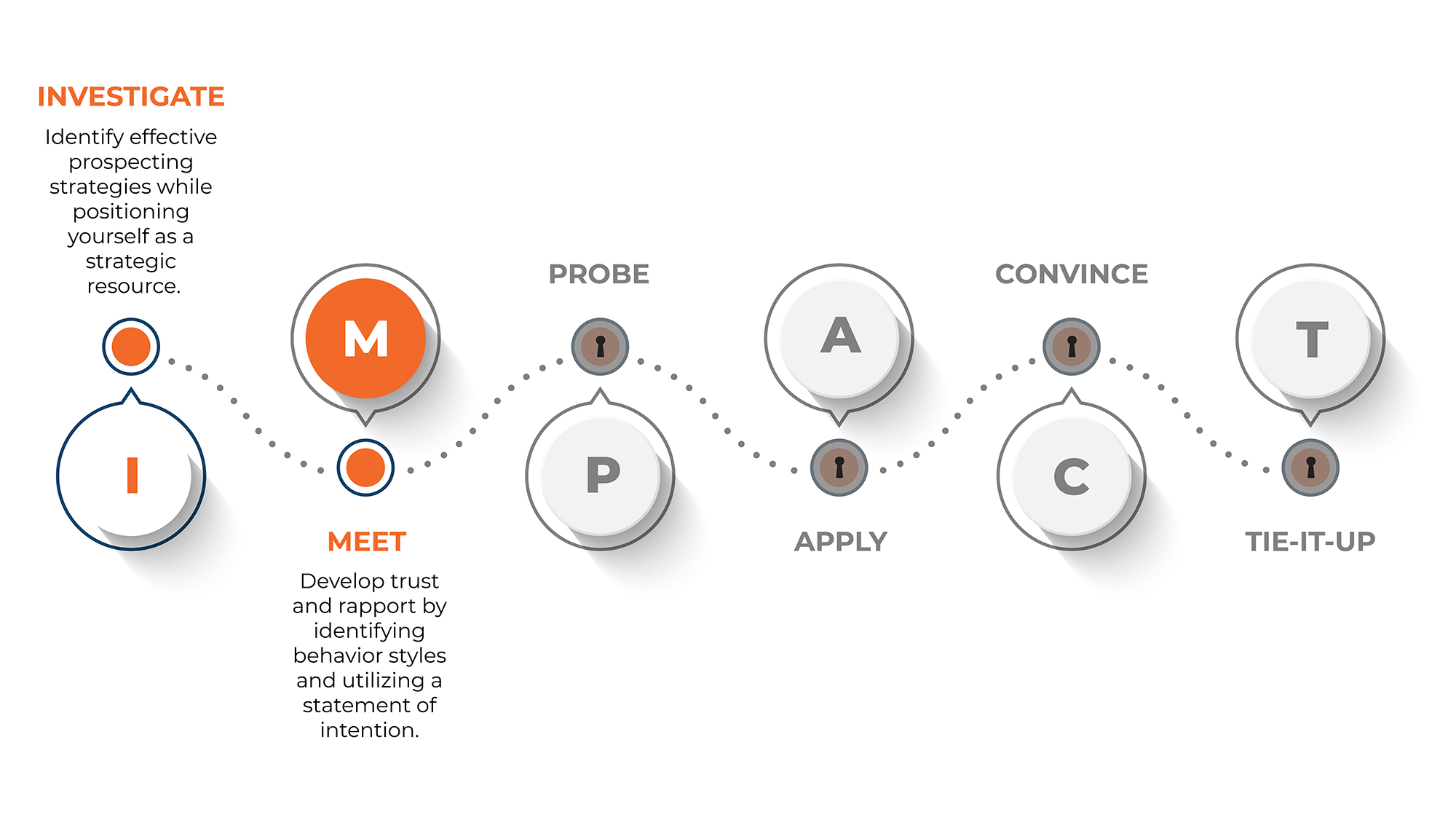This article is part of our Key Fundamentals of IMPACT Selling® series.
Opening the Meeting Is More Important Than You Know
Our culture seems to underemphasize the importance of starting off strong. So many “motivation quotes” essentially summarize the message as: it doesn’t matter how you start, as long as you finish strong.
While that prevailing mentality sounds nice, it is often far from the truth.
The process of tying up a sale doesn’t begin at the negotiation table after all the meetings have been had and solutions have been presented, but rather at the beginning of the sales process.
The Meet step of the IMPACT Selling® process is where the proverbial rubber meets the road.
Building Trust and Rapport With a Statement of Intention (SOI)
The goal of the Meet step is to develop rapport and trust with the buyer. Sales professionals must do everything in their power to create alignment with the customer’s buying agenda or process.
There are many aspects to an effective first meeting: approaching the customer in neutral, adapting to the customer’s behavior style, and ultimately agreeing to engage in a business conversation; but right now we’re going to focus on something called the Statement of Intention (SOI).
An effective Statement of Intention is customer focused and sets the tone for all interactions that follow. It’s not about what the sales professional wants to accomplish; it’s about what the customer wants to accomplish.
Customers need to see the purpose and value in meeting with your sales professional. If the customer is worried that they might be sold (aka convinced to do something they either don’t want to do or that isn’t in their best interest), they’re going to put their guard up. That will hurt trust, increase the buyer’s reluctance to engage with your seller, and make it difficult for the buyer to see your sales professional as a strategic resource. They may be able to go through the rest of the steps of IMPACT, but challenges during the Meet step usually culminate when it’s time to close the sale. This can trick even the best sales managers into thinking their team has a negotiation problem, when in reality they have an opening problem!
The Two Types of Statements of Intention
There are only two types of SOIs: effective and ineffective.
The sales professional and customer both have agendas. The salesperson can use the SOI to clearly align their agenda with what the buyer wants to accomplish! If the salesperson fails to do this, the prospect or customer will be forced to try and figure out the value of the meeting. Which again, will result in walls going up.
How about we get a little meta with an example?
Imagine you’ve filled out the contact us form requesting more information about our very own IMPACT Selling® Training. You’re now on the follow-up call with one of our sales professionals. Let’s compare the two ways the call can get started.
Effective:
Thank you for talking with me today. As outlined in the agenda I sent with our meeting confirmation, the purpose of our conversation today is to discuss your sales team and their development needs, and what you’re looking to accomplish from this initiative. That way, we’ll be able to determine together if IMPACT truly is the right fit for your needs. Before we begin, is there anything else you’d like to add to our agenda?
Ineffective :
I’m excited to learn that you’re interested in our IMPACT Selling Training program. I can’t wait to tell you more about IMPACT and the benefits it’s had for sales teams just like yours. It’s an award-winning program that I’m confident will have a positive result on your organization.
Do you see the difference? The good SOI example:
- Uses the words you and we more than I and me.
- Allows the sales professional to qualify the customer before presenting a solution.
- Tells the customer they will be doing most of the talking and the sales professional will be doing the listening.
- Positions the sales professional as a strategic resource to help the customer make a quality, informed decision.
While everything said in the ineffective example is true—our sales professionals are excited about the solutions we offer, IMPACT is an award-winning training, and it probably would benefit your organization—it’s focused on the seller’s agenda, not the buyer’s.
Coaching Questions for the Meet Step
Our CEO concluded his article about the Fundamentals of IMPACT by saying all salespeople have a blind spot. One of your jobs as a sales manager is to help people recognize where they need improvement and coach them as they work on those skills.
Sales professionals can’t communicate value before they build trust. Here are some questions to help you identify how proficient your sellers are with the Meet step.
- What does the customer want to accomplish with this meeting?
- What is your Statement of Intention?
- Is your Statement of Intention customer focused, and how does it align with the objectives of your call?
- Have you sent a meeting confirmation email that included a copy of the meeting agenda?
What Happens Next?
Be sure to follow the Sales Leader Blog to learn about the next step in our Key Fundamentals of IMPACT Selling® series: the Probe step. You’ll learn how to unlock your team’s mindset around questioning. When they ask better questions, they’ll get better answers and will have an easier time communicating value to the prospects and customers they serve.
If you do happen to schedule a call with a member of our team, be sure you listen to our Statement of Intention! We not only practice what we preach but are also happy to learn more about your sales organization to see if our training and assessments align with your sales enablement goals.




